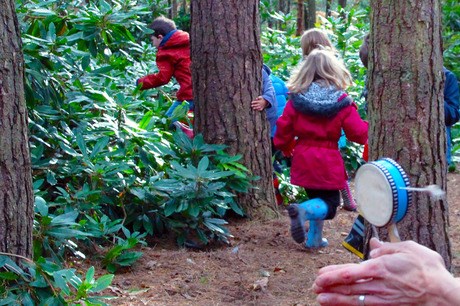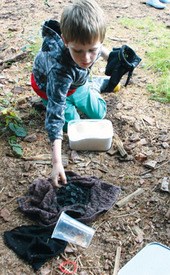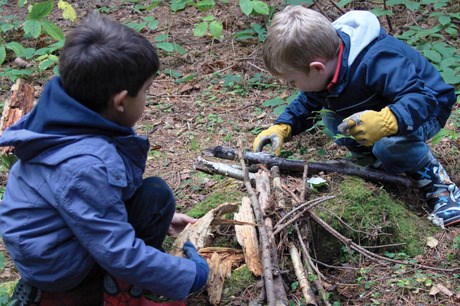Enabling Environments: Outdoors - Hit the trail
Ruth Thomson
Monday, October 19, 2015
In an extract from his book of story-based adventures, Adam Dove explains how woodland fairies and a big-footed troll can provide an exciting and engaging starting point for outdoor learning

This story of the woodland fairies and big-footed troll provides a springboard for activities that encourage children to work in groups and to learn basic woodcraft skills, tracking and how to build shelters. There is no expensive equipment needed (most materials can be found around the home), just enthusiasm and imagination.
THE WOODLAND FAIRIES AND BIG-FOOTED TROLL
Telling the story
Once upon a time, deep in the woods, there was an enchanted village where the fairies and their friends the pixies, elves and tree spirits lived happily together.
Each night, from sunset until sunrise, they would sing and dance and feast ... until one day a troll came to the village, a troll so big that he made the trees look like matchsticks.
Now, trolls may be gigantic but they are also very friendly and wouldn't dream of hurting a fly, but at the end of their long, long legs, they have enormous feet and sometimes their feet cause a lot of damage without the troll's head knowing anything about it. As he walked along, whistling and swinging his club, the troll's big feet squished and squashed all the fairies' houses and scared everyone away.
This morning, though, there was a sign that the fairies might be returning home. There was some fairy dust near the entrance to the village near an old tree.
Shall we welcome the fairies home by making them new houses? Until the fairies return home, though, we must ask the bog people to guard the village.

Setting up the adventure
You will need:
- Laying the trail: modelling clay, googly eyes (from craft suppliers), leaves, moss and pine cones.
- Water filters: fabric square/clean sock, plastic cups, rubber bands, sand, moss, charcoal and a plastic bottle of pond water.
- Fairy house: bark, sticks, fern fronds, pine cones and white flour.
- Things to make: modelling clay, googly eyes and gardening gloves.
- Games to play: hand-held drum.
First steps:
1. Laying the trail: make tree spirits. Press a ball of clay onto a tree trunk. Make a face using googly eyes, leaves for hair, a cone for a nose and moss for a beard. Position tree spirits on at least five trees to make a good trail. Have each one face towards the next tree and the final one looking at the fairy village.
2. Make water filters: you may need to make up the filter for the younger children. For each filter, tuck the square of fabric (or the toe end of the sock) into the plastic cup and secure with a rubber band. Fill with layers of charcoal, moss and sand. Fill a bottle with pond water or mix a handful of mud and leaf debris into tap water.
3. Make a fairy house: use pieces of bark, sticks, fern fronds, moss and pine cones. Keep the design simple. Sprinkle fairy dust (flour) in the area.
Things to make
Making bog people: give each child a lump of clay and a pair of googly eyes to make a bog person. Let them find other items from the forest, such as moss or feathers for hair, sticks for legs and arms, pine cone for a nose. When collecting materials, the children should wear gardening gloves to protect their hands. Get the children to think about what their bog person will need to survive until the fairies return home, for example, food to eat, water to drink and, to keep them warm and dry, a campfire and waterproof shelter.
 Making water filters: divide the children into groups, giving them the materials to make one water filter per group. Once they have finished making their filter, pour in some dirty water and it leave to settle. Show the children the before and after results, holding the cups up to the light. To get the children to think about food and water safety, ask them why the water in ponds, streams and rivers isn't safe to drink. Explain that although the filtered water they have just made is fine for the bog people and the fairies to drink, it wouldn't be safe for us. You could also ask them if we should eat food we find in the woods.
Making water filters: divide the children into groups, giving them the materials to make one water filter per group. Once they have finished making their filter, pour in some dirty water and it leave to settle. Show the children the before and after results, holding the cups up to the light. To get the children to think about food and water safety, ask them why the water in ponds, streams and rivers isn't safe to drink. Explain that although the filtered water they have just made is fine for the bog people and the fairies to drink, it wouldn't be safe for us. You could also ask them if we should eat food we find in the woods.
Games to play
The troll's drum game: when the children hear the troll drum sound they must run as fast as they can and hide before the drum stops beating. They must stay hidden and quiet until they hear you use your group's adventure call, 'Oi! Oi!'. They in turn must shout out their response, 'Eaaasy Tiger!', before coming out of hiding.
Following the trail
Finding the fairy village: divide the children into groups and let them take it in turns to find the tree spirits that lead the way to the fairy village. Tell the children to pay attention to the direction the tree spirits face and that the village will be marked by a sprinkling of fairy dust (white flour).
Completing the adventure
Rebuilding the village: once the children have found the sprinkling of fairy dust (flour), show them the house you have made and tell them the fairies need them to rebuild their village. Discuss what makes a good shelter, for example, a water-tight roof, a dry floor and walls. Collecting the materials to make the houses -branches, sticks, leaf litter - and building are ideal group activities. Give the children gloves to protect their hands.
Empty a watering can of water over each completed house to check for leaks; if the ground underneath stays dry, a bog person can move in. Ask the children what the bog person might find in the woods to eat.
Go foraging together for berries, nuts and leaves and pile them up in the shelter. Don't forget the cup of filtered water. Take this opportunity to discuss the dangers of foraging: tell children never to eat or pick anything in the woods unless they are with an adult.
To extend this adventure over to the next time the children return to the woods, place a fairy figurine alongside each bog person and tell the children how pleased the fairies were to find their village rebuilt.

What did we learn today?
- What makes a good shelter?
- Did your fairy house keep out the water? If not, what materials could you use to make it more waterproof?
- What things do fairies and bog people need to live in the woods?
- Should we eat or drink things we find in the woods? If we did, what might happen?
- Why should we wear gloves during this adventure? ?
Keeping safe
Discuss with children the dangers of drinking dirty water and eating things we find in the woods. If the children are very young it is best not to pick anything, such as berries, as they might copy you and eat something that could make them ill. When foraging in the woods, be aware of the potential dangers of handling potentially poisonous plants, fruits and nuts. In the absence of having an expert on hand, there are some excellent illustrated books available. Best play safe, though, and make it your rule that if in doubt, don't touch! Never let children pick wild mushrooms and toadstools.
This is an edited extract from Woodland Adventure Handbook by Adam Dove (£9.99, Frances Lincoln)
READER OFFER
 Woodland Adventure Handbook by Adam Dove (£9.99, Frances Lincoln) is a set of ten story-based adventures designed to connect children with nature, develop the senses and promote basic skills and positive dispositions for learning, including confidence and independence.
Woodland Adventure Handbook by Adam Dove (£9.99, Frances Lincoln) is a set of ten story-based adventures designed to connect children with nature, develop the senses and promote basic skills and positive dispositions for learning, including confidence and independence.
A qualified forest schools leader, the author found inspiration for the book in the Scandinavian model of early years education. Included are step-by-step instructions for each day of adventure, taking account of children's safety and providing inspiration for self-directed learning outdoors.
Nursery World readers can get a 20 per cent discount. To order for £8*, including postage and packaging, call 01903 828503 and quote offer code APG371. Or send a cheque made payable to Littlehampton Book Services Mail Order Department, Littlehampton Book Services, PO Box 4264, Worthing, West Sussex BN13 3TG. Please quote the offer code APG371 and include your name and address details.
*UK ONLY - please add £2.50 if ordering from overseas.




